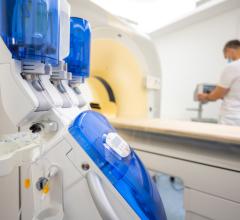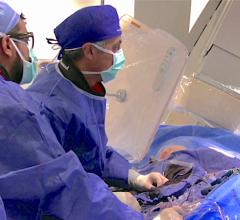As cutting-edge technologies collide with innovative treatments, a hybrid approach is emerging as the best path of action. In recent years, hospitals across the globe have reacted to the “blurring of the lines” between interventional and surgical procedures by installing suites that can accommodate an integrated treatment plan.
Hybrid interventional suites blend the capabilities of a true operating room (OR) with the highest-quality imaging support required for both minimally invasive procedures and open surgery. Shared by interventional radiologists, interventional cardiologists and surgeons, the rooms offer a modern solution to today’s changing needs.
The Imaging Advantage
The biggest benefit of this approach boils down to patient care, said Fabio Komlos, M.D., and interventional radiologist at the new El Camino Hospital in Mountain View, Calif. When the hospital opened its doors in
November 2009, a key feature of the design were five spacious interventional suites, outfitted with the latest imaging and surgical equipment, in the hospital’s OR wing.
“It’s in the best interest of the patient,” Dr. Komlos said. “Then you can have all the best available treatment at the same time, and get the procedure done at once in a safe way. Everything you do, you have the best way of seeing what you’re doing.”
All five suites have ultrasound, fluoroscopy, angiograph and dynamic CT scans, he adds, which essentially enhances the radiologist’s or surgeon’s ability to perform procedures optimally.
“A lot of things that are done in the OR are done kind of blindly,” he said. “With this, we can be very precise and go exactly where you want to go and do exactly what you want to do.”
El Camino typically uses the rooms to perform more complex procedures, such as to treat abdominal aortic aneurysms and peripheral arterial disease (PAD), he said. Other hospitals also use interventional suites for the treatment for carotid stenting, strokes and radiofrequency ablation.
The hospital partnered with vendors Siemens and McKesson to install the majority of the imaging equipment in the rooms. Each of the approximately 650-square-foot hybrid suites have Siemens’ Axiom Artis Zee imaging equipment with 30 x 40 cm flat detectors. The hospital has three ceiling mounted, one floor mounted and one biplane room. The
hemodynamic systems came from McKesson.
Because it was a brand new hospital and everything was “built from scratch,” the hospital made the best effort to ensure all the equipment communicates with each other in the suites, as well as communicates with the overall hospital systems, Dr. Komlos said.
For Juan Rodriguez, M.D., also an interventional radiologist at El Camino, the hybrid suites reflect an overall shift toward a less invasive, interdisciplinary approach in the medical community.
“We are moving from incisions to puncture sites to hopefully seamless intervention. The interdisciplinary approach is not something that belongs to one specialty,” Dr. Rodriguez said. “What’s going to make a big difference for patients is the integration of hardware and people involved in management. The more segmented the care is, the more chances for error. The more integration, the better the outcome.”
Mauro Romano, cardiac surgeon at the Institut Hospitalier of Jacques Cartier in Massy, France, agrees. This approach has already been embraced throughout Europe, he said. “I don’t think this is just a trend or something that is in fashion,”
Dr. Romano said. “This is an evolution. Maybe even a revolution.”
The Best of Both Worlds
The French medical center’s adoption of new heart valve and endovascular therapies, which require a surgical setting in addition to high-quality imaging systems, fueled its decision to install the Allura Xper FD20 system from Philips Healthcare. From planning to execution, the process lasted from September 2007 to May 2008, when the hybrid suite officially opened. In the short period of time it has been in use, Romano is impressed with the striking difference in imaging quality and the potential to treat complex cases more effectively.
“[A hybrid approach] can offer better solutions to difficult and complex problems,” he said.
Back in the states, hospitals working with hybrid suites emphasize the distinct advantages of the rooms. Dr. Komlos lists the many perks the rooms provide: Being able to do all the procedures in one setting, the integration of various modalities for best outcome, patient safety, and the opportunity it offers physicians to be more creative.
In spite of the heavy initial investment — at El Camino Hospital, outfitting each of the five hybrid suites with the necessary equipment cost $1-2 million — there are cost benefits down the road.
“The fact you can do everything at once saves costs,” he said. “If the patient has to come in once to have a procedure, then come back two weeks later for a different one, then I’m sure the costs of that would be much higher.”
At the Hospital of the University of Pennsylvania, Howard Herrmann, M.D., director of interventional cardiology and director of cardiac cath labs, describes it as “the best of both worlds.”
When the hospital began doing its first FDA trial transcatheter aortic valves implantations in November 2007, it turned to Siemens for help upgrading a vascular surgical room with cardiology catherization equipment, resulting in the hospital’s first truly hybrid suite. The room is now equipped with hemodynamic monitoring and can function fully as an OR and/or a cath lab.
“We use it primarily for transcatheter aortic valve implantations,”
said Dr. Herrmann.
The increasingly popular procedure — although not yet an FDA approved technique — requires an OR setting to do the job optimally, he said. “Right now, with the current size of transcatheter valves, the access from the femoral artery still requires a surgical cut down in most patients. We think a hybrid room is a better place to do these things because it is more sterile, and it is easier to transport the catherization skills to an OR that is adequately outfitted than vice versa,” Dr. Herrmann said.
“From my standpoint, it basically gives us the advantages of an operating room in terms of sterility, the availability [to do] cardiac pulmonary bypass for complications, and easy availability to general anesthesia; the kinds of things that are more difficult to arrange in the cath lab than in the OR,” he added.
As volume continued to grow, a second hybrid OR equipped with the latest imaging technologies was built next door and is primarily used for vascular surgery and stent graft implants. It opened its doors on January 2010.
Vincent Olshove, CCP, CCT, manager of cardiac catherization at Nationwide Children’s Hospital in Columbus, Ohio, said what fueled the hospital’s adoption of the hybrid room was the need to better treat patients,
especially those being treated for hypoplastic left heart syndrome.
“What drove it was that we had these patients in limbo,” Olshove described. “They would have to come in and potentially have a diagnostic/interventional cath, then maybe have to go over for a surgery, and then have potential issues afterwards and come back to the cath lab.”
“The best time to deal with [a complication] is while you are right there with the patient on the surgical table with his or her chest open, not a day or two or three days later when they’re in the ICU, and they’ve struggled for the last couple of days, and now they’re sicker, and you have to take them back to the cath lab or OR. We could knock some of that out by just doing it all at one place,” he said.
An early adopter of the hybrid model, Nationwide began with two hybrid cath suites supplied by Toshiba in 2004. They were built around the interventional team, but with the ability to support hybrid procedures. Later, in 2007, the hospital constructed a hybrid OR built around the surgical team, yet capable of doing surgery or interventional procedures.
The transition to the hybrid model has been well received by patients.
“From a patient perspective, we’ve changed how we’ve done things a bit. It’s much more convenient for them now.”
These days, their patients are typically scheduled for both an interventional procedure and cardiac surgery as a “back up” if the interventional team is unable to resolve the problem.
“The frequency with which we use these rooms for hybrid type equipment continues to increase,” Olshove added.
Key Imaging Solutions
Several vendors, including Siemens, Philips, GE and Toshiba, have carved a niche as the lead providers of the key modalities used in interventional suites today.
The recent integration of GE Healthcare’s Innova imaging systems and the Veran ig4 navigation system, announced during RSNA 2009 in Chicago, seeks to aid visualization during interventional procedures. The system is designed to support interventional radiologists, but will likely also find applications in cardiac and EP cath lab procedures.
Veran ig4 is a multimodality navigation system that utilizes electromagnetic localization and image fusion to display an interventional instrument, such as a biopsy needle, an aspiration needle, or an ablation needle, on a computer monitor that also displays a CT-based model of the target organ(s).
GE’s Innova imaging systems acquire computerized tomography-like patient images, which under the terms of the agreement, can be exported to the Veran ig4 navigation system in the same imaging suite, during the same interventional procedure.
Philips Healthcare recently introduced improvements to its Allura Xper FD20 system with the MR/CT Roadmap feature, which allows clinicians to synchronize live fluoroscopy with previously acquired MRA/CTA datasets. XperGuide can also overlay live fluoroscopy on MR/CT images for needle image guidance.
Last year, the company also acquired Traxtal and its portfolio of minimally invasive instruments and software for image-guided intervention and therapy. PercuNav functions as a GPS for medical instruments and is now integrated into the Philips interventional suite of products. The system provides 3D visualization and navigation tools to guide instruments to desired targets.
The system tracks the tips of flexible and rigid instruments while inside the patient and displays the instrument position, orientation and trajectory on pre-procedure and intra-procedure images. It can generate fused multimodality images, such as CT with real-time ultrasound, which can aid in procedures such as biopsy and ablation.
The launch of the integrated CX50 system also seeks to improve ultrasound access and use. With the CX50’s portability, physicians in the cath lab can control the CX50 from the Allura Xper FD tableside module, and view images directly on interventional exam room monitors.
Siemens’ Artis zee family of systems features an enhanced imaging chain — spanning image acquisition to image processing and documentation — designed to deliver sharply detailed images required for interventional procedures. The Artis zee angiography unit is engineered to provide clarity in 2D imaging, and enable an array of 3D imaging applications to help support clinical decision making.
The Artis zeego, part of the product line, features a robotic-assisted positioning capability for interventions in both radiology and the developing OR environment. Artis zeego’s flexibility of movement is linked to syngo DynaCT, from which the operator more comfortably controls and positions the table during long and complex procedures. The table’s parking positions are also designed to maximize the use of room space.
Toshiba America Medical Systems’ new Infinix VF-i/BP with large and mid-sized flat panel detectors provide clinicians with the ability to obtain critical variations in angle combinations, while providing the necessary anatomical coverage. This bi-plane vascular X-ray system has several clinical applications.
It Takes a Village
Across the board, experts agree that a spirit of collaboration among all stakeholders is key to the successful installation of a hybrid room.
“Everyone needs to be on the same [page],” Dr. Komlos said.
“It takes a lot of commitment from the center and from the teams that are involved. Having everyone on board as to what the potential vision is to make this work certainly takes a lot of meetings and open minds,” agreed Olshove. “Not just at the physician level, but all the way down to personnel.”
Dr. Herrmann equates his first experiences working in the new hybrid OR at the Hospital of the University of Pennsylvania as playing in an “away game.”
“It was a foreign room. I didn’t feel quite as comfortable as I did in my own cath lab,” he said. “But with time and mutual respect by all parties, it became an extension of the cath labs.”
It’s critical that all potential end users have input into the design process to make sure no detail, large or small, is missed.
While more challenging, the overall experience is enriched when doctors across specialties are able to work along side one another.
“It’s much enriched,” said Dr. Rodriguez. “You bring to the dish much more flavor when you [employ] different techniques. Through collaboration and [having an open mind], you can evolve the field that much faster than through keeping doors closed.”
Having a Game Plan
Richard B. Shafer, director of project design and planning group for Steris Corp., warns that creating such a room in any hospital requires serious work and strategic planning.
“The hybrid interventional suite is one of the most complex rooms to design and plan in a hospital. The key is getting the clinical staff to make decisions early on [regarding] who will be involved with the planning,” he said.
“The architect, imaging company and surgical support company must work together as a collaborative team to plan the space, and must gather input from the clinical personnel who will actually use the room for the procedure.”
Shafer recommends that hospitals choose an architect who has experience in complex procedural room designs and select the imaging and surgical support companies that you will work with early on in the process, while the schematic designs are first being developed. “The imaging companies use different support systems to support their technologies (ceiling-based, floor-based and robotic arm-based), so it is essential to make those decisions early.”
Unlike most one-room projects where few parties are involved, hybrid suites can incorporate teams of up to 20 individuals representing all stakeholders, agreed Jim Norris, senior manager of market development for Steris. Because of the inherent complexities of the project, Norris advises hospitals to not “fast track” the process and allow 12 to 18 months for solid planning and build out.
Given the rapidly changing nature of the field and the imaging technologies used, it’s important that hospital planners build in the potential for upgrading and adding equipment when designing the suites.
“The rooms should be able to handle [changes and additions] from a structural point of view,” said Dr. Rodriguez. “There’s going to be some modifications. The field is in constant evolution.”
Navigating Road Blocks
The journey from conception to construction is not without road blocks. Hospitals considering building hybrid suites should be aware that certain challenges can arise, including making sense of multiple definitions/expectations of a hybrid suite; space and flexibility needs to accommodate many technologies and personnel; internal “turf wars;” and, of course, cost.
Taking the time to visit different hospitals that have gone through this process and learning from their experiences can make the transition smoother.
“The biggest thing I would advise is to get a multidisciplinary group together and go out and talk to people who have done it as a group. That will help point out things that you may miss,” said Olshove.
Pushing the Envelope
While the hybrid suite might not be ideal for every hospital — it
depends on the types of procedures being performed and the hospital’s financial strength — it is gaining momentum as the wave of the future.
However, as medical technology pushes the envelope on minimally invasive procedures, the stakes get higher.
“As technology emerges and we’re coming out with newer procedures and newer ways of doing things, we’re also going to run into situations where we have potentially higher-risk complications that need to be treated immediately, when there is no time to move a patient from point A to point B,” said Olshove.
Perhaps most exciting of all, he adds, is the realization of all the doors the hybrid approach can unlock.
“We’re still discovering what our capabilities are,” Olshove said. “You’re only limited by the imaginations of the people involved.”


 August 14, 2025
August 14, 2025 








